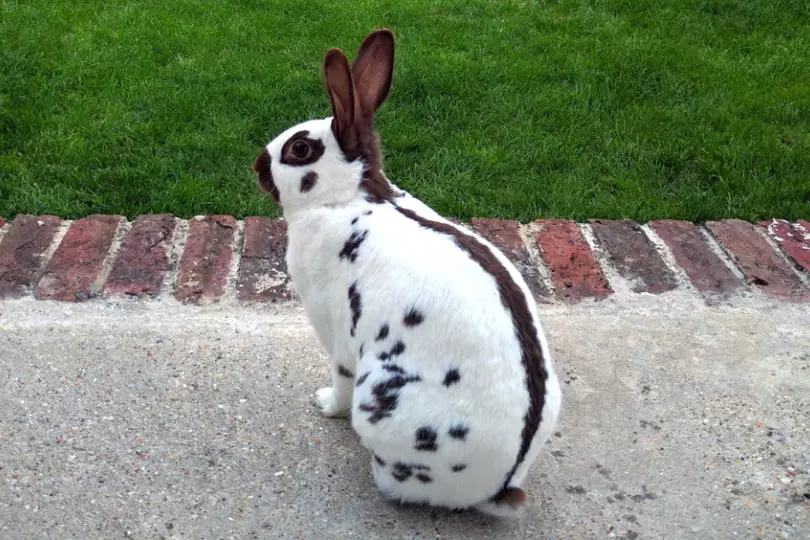Basic Appearance:
The English spot is a full arch breed, with a long, lean body and a beautiful spotted pattern on its white coat. English spots have a nose marking called a “butterfly,” eye circles, cheek spots, colored ears, and a strip of color down their back called a “herringbone.” They have side markings consisting of distinct round spots that should start on the shoulder and sweep down the side and broaden at the hips.
History, Temperament, and Common Uses:
The precise origin of English spots is unknown, but they have been in England since the 1850’s. They were recognized in the United States in 1924.
English spots are friendly, inquisitive, and energetic. In fact, when judging this breed, they are not posed. Instead they are encouraged to run the length of the table. This is the best way to evaluate their body type and markings.
English spots are, and have been from the beginning, a “fancy breed,” meaning they are used mainly as show rabbits. With all their markings they are a challenge to raise, but a well-marked spot makes it all worthwhile.
English spots can also make good pets, since they generally have a nice personality.
Grooming, Care, and Additional Notes:
English spots have flyback fur, which needs little grooming. Going over their coat once or twice a week with a bristle brush or damp hands should be enough to keep your spots looking nice. When rabbits are molting, they will need groomed more often. You can use a slicker brush to gently remove loose fur.
English Spot At A Glance…
Recognized Varieties:
Black, blue, chocolate, gold, gray, lilac, and tortoise.
ARBA Body Type:
Full Arch
Approximate Size:
5 to 8 pounds
Important Things to Look for When Buying Show Stock:
Even though markings carry the most points in English spots, type is important as well. Their body should be well off the table. Hips should have good depth, be well rounded, and only slightly broader than the shoulders, but not making a wedge shape. Look for balance of body and a full arch.
Legs should be medium to fine boned, long and slender. The hind legs should be parallel with the body. Colored toenails are allowed.
The ears should be erect. Bucks will have broader heads than does.
Fur should be flyback. It should be short, dense, and fine. There should be plenty of guard hairs to give it a high luster. The coat should be even and clean. English spots should look sleek and smooth.
Color should match the standard.
Markings have the most points in the English spot standard. All markings should be clean and distinct.
Head markings consist of a butterfly, eye circles, and cheek spots.
The ears should be completely colored, with a clear line where the marking meets the base of the ears.
The herringbone, or spine marking, should be an unbroken line from the ear base to the tip of the tail. The edges should be ragged, giving it a herringbone effect. The spine marking should broaden out at the saddle to the widest part at the hips, than narrow back down towards the tail.
The side pattern consists of three groups of markings: the chain, body, and hips. The chain spots start at the nape of the neck, with a single spot that is to be about 3/16 of an inch in diameter. The spots of the chain continue down towards the stomach, increasing in size and number. The largest spot of the chain should be about 3/8 of an inch in diameter. The body markings connect the chain and hip markings. They should form a line along the stomach, sweeping up towards the hip markings. In size the spots of the body marking should be larger than those of the chain marking, but smaller than the spots of the hip marking. The hip markings should be on the hindquarters, and almost touch the spine marking. The largest spot should be no larger than a penny. The side pattern should be an unbroken sweep of spots increasing in number and size of spots from the chain to the hip. Both sides of an English spot should have matching markings.
Six belly or teat spots are desirable. A stripe down the belly is allowed, but not desired.
One spot on each elbow and hock is desirable.
Things to Avoid:
Flat body type, body type without arch, close coupled body, chopped hindquarters.
Short legs, weak ankles of forelegs, hind legs not parallel with body, or hind legs too close together.
Bulldog head, narrow head, poor ear carriage.
Coat long or thin, long guard hairs, poor density, lacking luster.
Markings:
– Butterfly irregularly shaped, drags of color into white, runs of white into color. Split butterfly or white spots in butterfly are a disqualification.
– Eye circles very large or small, uneven. Lack of one or both eye circles is a disqualification.
– Cheek spots large, lacking balance, or not round. Missing cheek spots, double or split cheek spots are a disqualification.
– Ear markings without clean line at base (dirty ear base). White hairs, mealiness, frostiness, very light color. White spots in upper half of ear is a disqualification.
– Herringbone with break, faded or weak color at tail, smooth edges. More than one break, including late start, is a disqualification. Any break that is more than 1/4 inch is a disqualification.
– Side markings not showing proper pattern, lack of sweeping pattern, stray spots, congested spots, pattern very plain, gaps of the pattern, blotchy or barred spots. Feathered pattern. No graduation in spot size. Side markings not balanced. Absence of side markings from one or both sides is a disqualification.

